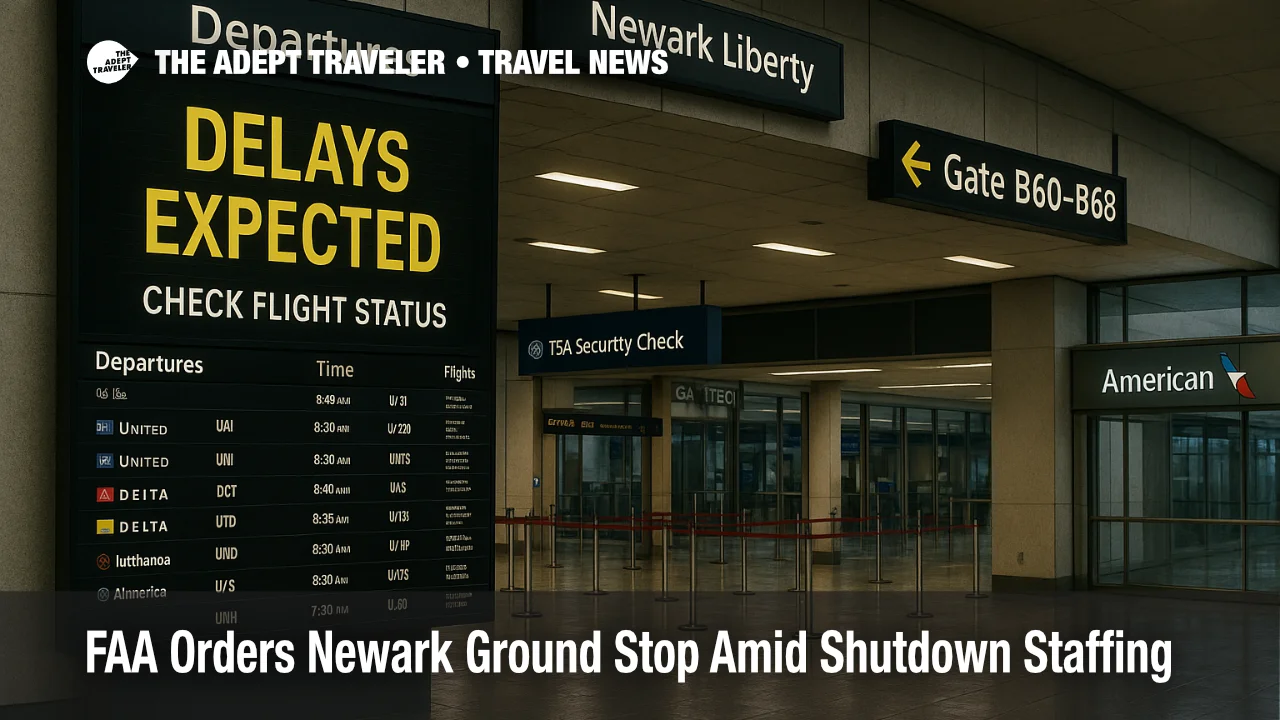FAA Orders Newark Ground Stop Amid Shutdown Staffing

Key points
- FAA imposed a roughly 75-minute ground stop at Newark Liberty International Airport on October 29, 2025
- The government shutdown has strained air traffic control staffing, contributing to mounting delays nationally
- NAS Status and ATCSCC advisories flagged potential ground stops and delay programs for EWR through the afternoon
- Travelers faced residual delays after the halt was lifted, with airlines working through backlogs
Impact
- Who Is Affected
- Passengers flying to or from Newark this afternoon and evening, plus those connecting via the airport
- Timing
- Residual delays may persist into late evening on October 29, 2025 as airlines recover schedules
- What To Do
- Check your airline app for rebooking options and monitor the FAA NAS Status page before heading to the airport
- Alternates
- Consider LaGuardia or JFK only if your carrier can rebook you there and you can adjust ground transport
- Connections
- Build extra buffer time for tight connections and last-flight-of-the-day itineraries
The Federal Aviation Administration ordered a ground stop at Newark Liberty International Airport (EWR) on October 29, 2025, pausing most departures and certain arrivals for roughly 75 minutes on Wednesday afternoon. The FAA cited staffing issues at air traffic control facilities as the trigger, a problem that has intensified during the ongoing federal government shutdown. Operations resumed after the halt, but airlines warned of lingering delays as schedules reset and crews and aircraft returned to position.
FAA And Airport Status
Local outlets reported the ground stop began in the afternoon and lasted about an hour and a quarter before being lifted, aligning with FAA operations data that showed Newark flagged for potential ground stops and delay programs during the afternoon recovery window. The FAA's National Airspace System Status board listed EWR among airports subject to ground stop or delay-program conditions, a signal to carriers and travelers that knock-on delays could continue even after flights began moving again.
While a formal ATCSCC (Air Traffic Control System Command Center) ground-stop advisory is typically logged in the FAA Advisory Database, the most accessible public indicators for travelers during fast-moving events are the live NAS Status pages and the Current Operations Plan advisories that reflect rolling constraints as they are added or canceled. These sources showed Newark in a watch posture for programs on Wednesday as the stop took effect and recovery started.
Why Staffing Triggered A Ground Stop
The shutdown has left thousands of air traffic controllers and other safety-critical staff working without pay, increasing fatigue and absenteeism. In recent days the FAA has acknowledged that controller staffing shortfalls are contributing to a larger share of nationwide delays than usual, and that New York-area facilities are among the hardest hit. As the shutdown has dragged on, major media and wire services have documented controllers taking second jobs or missing paychecks, which unions warn can erode staffing stability. That strain raises the likelihood of episodic ground stops when staffing dips below safe thresholds at critical facilities, as appeared to be the case at Newark on Wednesday.
Latest Developments
Financial and national outlets tracked Wednesday's halt and the broader pattern of staffing-related constraints at Newark and other large hubs. Bloomberg reported the FAA delayed Newark flights amid a controller crunch, while Associated Press and local NBC coverage earlier in the week detailed similar shutdown-era pauses at Los Angeles International Airport, underscoring how quickly staffing shocks can ripple through the system. Although weather still causes many delays, the FAA has recently attributed an unusually high share to staffing triggers during the shutdown.
Analysis
A ground stop is a traffic-flow management tool the FAA uses to meter inbound and outbound demand when capacity temporarily falls at an airport or facility, whether from weather, equipment outages, or staffing. During a stop, flights yet to depart for the affected airport are held at origin, while local departures may also be paused. Once the stop lifts, the FAA may transition to a Ground Delay Program or simply allow controlled resumption, depending on how quickly staffing and runway capacity rebound. The FAA's advisory and NAS pages provide the earliest public indication of these shifts, but practical recovery depends on aircraft and crew availability, gate turns, and curfew constraints, which can push some flights to cancellations if delays creep toward the last bank of the day.
For Newark travelers, the immediate risk on Wednesday is schedule slippage into the evening, when re-crewing and aircraft rotations become harder. If your itinerary includes a tight domestic-to-international connection, ask your airline to protect you on a later onward flight or route you through a different hub. If you are still at home and your airline shows a significant delay, you will usually have more options by staying put and using the app or text prompts to rebook rather than heading to the airport. Flyers with flexibility sometimes find better outcomes by moving to earlier flights on Thursday morning, when crews reset and overnight maintenance clears backlogs.
Final thoughts
The FAA's shutdown-era staffing strain is now producing occasional, time-boxed ground stops at major hubs, including Newark Liberty International Airport, with residual delays that can outlast the initial pause. Until federal funding is restored, travelers should assume higher volatility, build buffers into connections, and monitor FAA and airline channels closely for day-of-travel changes.
Sources
- NBC New York, "Newark Airport ground stop ordered over staffing issues"
- FAA NAS Status, Active Airport Events for EWR
- FAA NAS Status, National Airspace System Status Landing Page
- FAA ATCSCC, Current Operations Plan/Advisory Database
- Bloomberg, "FAA Delays Newark Airport Flights on Controller Staffing Crunch"
- Reuters, "FAA says US air traffic control staffing issues causing flight delays"
- Reuters, "Hundreds of air traffic controllers take second jobs as shutdown continues"
- AP News, "Flights to Los Angeles International Airport halted due to air traffic controller shortage"
